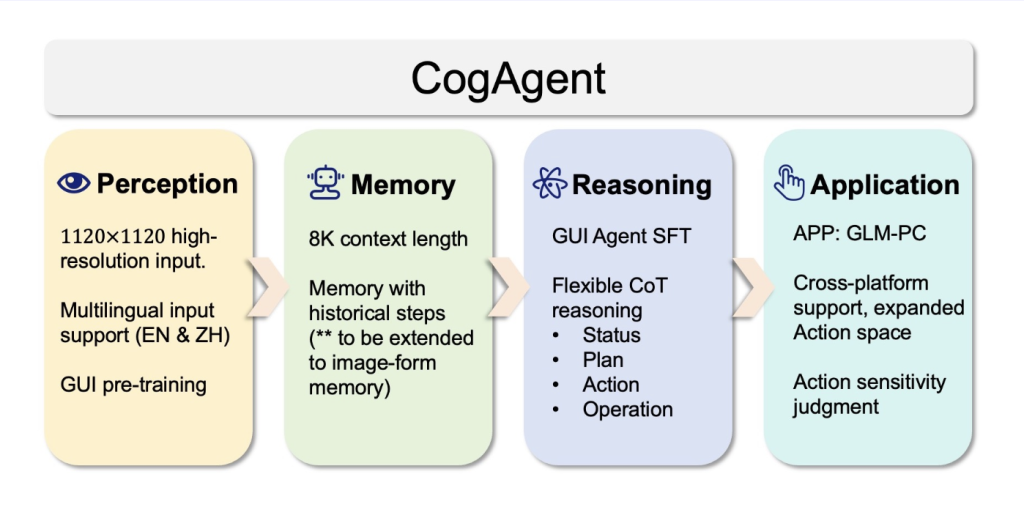

Graphical User Interfaces (GUIs) are central to how users engage with software. However, building intelligent agents capable of effectively navigating GUIs has been a persistent challenge. The difficulties arise from the need to understand visual context, accommodate dynamic and varied GUI designs, and integrate these systems with language models for intuitive operation. Traditional methods often struggle with adaptability, especially in handling complex layouts or frequent changes in GUIs. These limitations have slowed progress in automating GUI-related tasks, such as software testing, accessibility enhancements, and routine task automation.
Researchers from Tsinghua University have just open-sourced and introduced CogAgent-9B-20241220, the latest version of CogAgent. CogAgent is an open-source GUI agent model powered by Visual Language Models (VLMs). This tool addresses the shortcomings of conventional approaches by combining visual and linguistic capabilities, enabling it to navigate and interact with GUIs effectively. CogAgent features a modular and extensible design, making it a valuable resource for both developers and researchers. Hosted on GitHub, the project promotes accessibility and collaboration within the community.
At its core, CogAgent interprets GUI components and their functionalities by leveraging VLMs. By processing both visual layouts and semantic information, it can execute tasks like clicking buttons, entering text, and navigating menus with precision and reliability.
Technical Details and Benefits
CogAgent’s architecture is built on advanced VLMs, optimized to handle both visual data, such as screenshots, and textual information simultaneously. It incorporates a dual-stream attention mechanism that maps visual elements (e.g., buttons and icons) to their textual labels or descriptions, enhancing its ability to predict user intent and execute relevant actions.
One of the standout features of CogAgent is its capacity to generalize across a wide variety of GUIs without requiring extensive retraining. Transfer learning techniques enable the model to adapt quickly to new layouts and interaction patterns. Additionally, it integrates reinforcement learning, allowing it to refine its performance through feedback. Its modular design supports seamless integration with third-party tools and datasets, making it versatile for different applications.

The benefits of CogAgent include:
- Improved Accuracy: By integrating visual and linguistic cues, the model achieves higher precision compared to traditional GUI automation solutions.
- Flexibility and Scalability: Its design allows it to work across diverse industries and platforms with minimal adjustments.
- Community-Driven Development: As an open-source project, CogAgent fosters collaboration and innovation, encouraging a broader range of applications and improvements.
Results and Insights
Evaluations of CogAgent highlight its effectiveness. According to its technical report, the model achieved leading performance in benchmarks for GUI interaction. For example, it excelled in automating software navigation tasks, surpassing existing methods in both accuracy and speed. Testers noted its ability to manage complex layouts and challenging scenarios with remarkable competence.
Additionally, CogAgent demonstrated significant efficiency in data usage. Experiments revealed that it required up to 50% fewer labeled examples compared to traditional models, making it cost-effective and practical for real-world deployment. It further enhanced its adaptability and performance over time, as the model learned from user interactions and specific application contexts.

Conclusion
CogAgent offers a thoughtful and practical solution to longstanding challenges in GUI interaction. By combining the strengths of Visual Language Models with a user-focused design, researchers at Tsinghua University have created a tool that is both effective and accessible. Its open-source nature ensures that the broader community can contribute to its growth, unlocking new possibilities for software automation and accessibility. As an innovation in GUI interaction, CogAgent marks a step forward in creating intelligent, adaptable agents that can meet diverse user needs.
Check out the Technical Report and GitHub Page. All credit for this research goes to the researchers of this project. Also, don’t forget to follow us on Twitter and join our Telegram Channel and LinkedIn Group. Don’t Forget to join our 60k+ ML SubReddit.
The post Tsinghua University Researchers Just Open-Sourced CogAgent-9B-20241220: The Latest Version of CogAgent appeared first on MarkTechPost.
Source: Read MoreÂ

 Trending: LG AI Research Releases EXAONE 3.5: Three Open-Source Bilingual Frontier AI-level Models Delivering Unmatched Instruction Following and Long Context Understanding for Global Leadership in Generative AI Excellence….
Trending: LG AI Research Releases EXAONE 3.5: Three Open-Source Bilingual Frontier AI-level Models Delivering Unmatched Instruction Following and Long Context Understanding for Global Leadership in Generative AI Excellence….